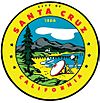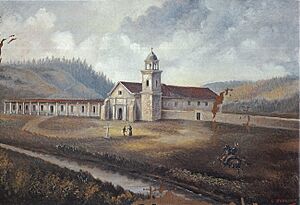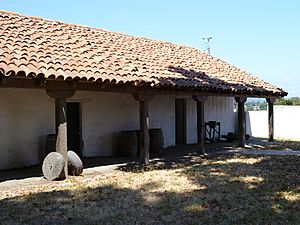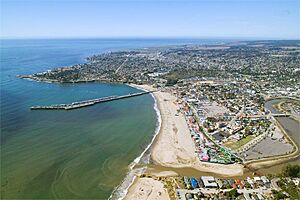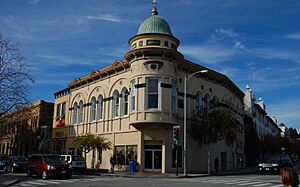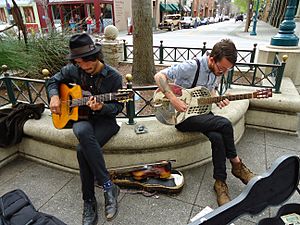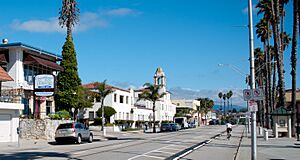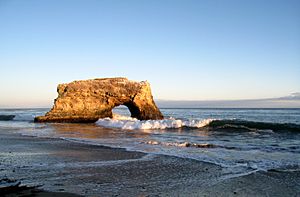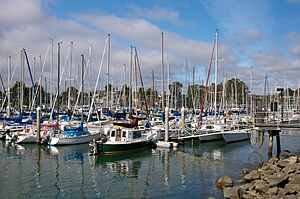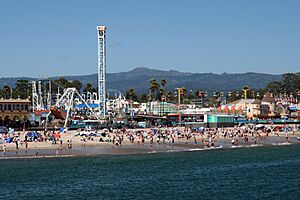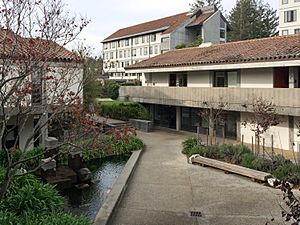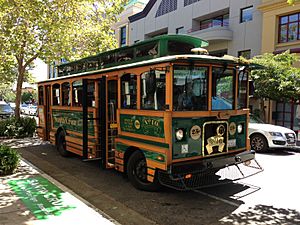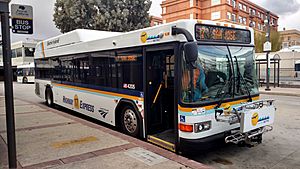Santa Cruz, California facts for kids
Quick facts for kids
Santa Cruz
|
|||
|---|---|---|---|
| City of Santa Cruz | |||
|
View of downtown Santa Cruz
Mission Santa Cruz replica
Santa Cruz coastline
The historic post office
Downtown Santa Cruz
|
|||
|
|||
| Nickname(s):
Surf City
|
|||
| Country | United States | ||
| State | California | ||
| County | Santa Cruz | ||
| Mission | September 25, 1791 | ||
| Incorporated | March 31, 1866 | ||
| Chartered | April 1876 | ||
| Government | |||
| • Type | Council/Manager | ||
| Area | |||
| • City | 15.83 sq mi (41.00 km2) | ||
| • Land | 12.74 sq mi (33.00 km2) | ||
| • Water | 3.09 sq mi (8.00 km2) 19.51% | ||
| • Urban | 58.4 sq mi (151.1 km2) | ||
| • Metro | 607 sq mi (1,570 km2) | ||
| Elevation | 36 ft (11 m) | ||
| Population
(2020)
|
|||
| • City | 62,956 | ||
| • Estimate
(2022)
|
64,075 | ||
| • Density | 3,977.0/sq mi (1,535.51/km2) | ||
| • Urban | 163,703 | ||
| • Metro | 262,382 | ||
| Time zone | UTC−8 (Pacific) | ||
| • Summer (DST) | UTC−7 (PDT) | ||
| ZIP codes |
95060–95067
|
||
| Area code | 831 | ||
| FIPS code | 06-69112 | ||
| GNIS feature IDs | 1659596, 2411820 | ||
Santa Cruz is a city in California, located on the northern edge of Monterey Bay. Its name means "Holy Cross" in Spanish. It is the biggest city and the main government center of Santa Cruz County. In 2020, about 62,956 people lived there.
Santa Cruz is a popular place for tourists. People love its beautiful beaches, the exciting surf culture, and its many historic places. The city was started by the Spanish in 1791. This happened when Fermín de Lasuén built Mission Santa Cruz.
Over time, Santa Cruz grew. It became a town in 1866 and a special "charter city" in 1876. The Santa Cruz Beach Boardwalk, built in 1904, helped make it a famous beach vacation spot. Later, the University of California, Santa Cruz opened in 1965, turning Santa Cruz into a lively college town.
Contents
History of Santa Cruz
Early People in Santa Cruz
People have lived in the Santa Cruz area for at least 12,000 years. Before the Spanish arrived, the Awaswas nation of Ohlone people lived here. Their land stretched from north of Davenport to Rio Del Mar.
The Awaswas tribe had about 1,000 people. Their language is now gone. Only a few local place names remain from their language: Aptos, Soquel, and Zayante. The name of a shellfish, abalone, also comes from their language. The native people called this area Aulinta.
Spanish Arrival and Missions
The first Europeans to explore California by land came through Santa Cruz in 1769. This was the Spanish Portolá expedition. On October 17, 1769, they crossed a river, which they named San Lorenzo.
The next day, they found a stream and named it "El Arroyo de la Santísima Cruz." This means "The Stream of the Most Holy Cross."
In 1791, Father Fermín Lasuén used this name to start La Misión de la Exaltación de la Santa Cruz. This mission was built to teach the Awaswas people. Santa Cruz was the twelfth mission built in California. The stream later became known as Laurel Creek.
In 1797, a town called Villa de Branciforte was started near the mission. It was named after a Spanish leader. This was one of only three towns started by the Spanish in California. The other two became Los Angeles and San Jose. The Villa de Branciforte later became part of the City of Santa Cruz in 1905.
Mexican Rule and Changes
In the 1820s, Mexico became independent from Spain and took control of the area. The Santa Cruz mission, like others, was closed down in 1833. The land that belonged to the mission was then divided into large private land grants called ranchos.
Two of these ranchos were inside what is now Santa Cruz city. These were Rancho Potrero Y Rincon de San Pedro Regalado and Rancho Tres Ojos de Agua. Other rancho lands also became part of the city later.
After the land was privatized, more people from the United States started to arrive. In 1848, after a war, Mexico gave California to the U.S.
The old mission buildings started to fall apart. A new church was built in 1858. The current Holy Cross church was built on the site in 1889.
Santa Cruz in the United States
California became a U.S. state in 1850. Santa Cruz County was created that same year, and Santa Cruz became its main city. Santa Cruz became a town in 1866 and a special "charter city" in 1876.
More people moved to Santa Cruz from the eastern U.S. Elihu Anthony arrived in 1847 and helped build many firsts for the city. He opened the first Protestant Church and the first blacksmith shop. He also built the first wharf and was the first postmaster.
Railroad lines came to Santa Cruz in 1875–76. This helped industries like timber, leather, and limestone to grow.
The California Powder Works started making blasting powder during the American Civil War. They used local wood to make charcoal and powder kegs.
Santa Cruz was badly damaged by the 1989 Loma Prieta earthquake. It also faced damage from ocean waves caused by the 2011 Tōhoku earthquake and tsunami and the 2022 Hunga Tonga–Hunga Ha'apai eruption and tsunami.
In 1998, Santa Cruz declared itself a "nuclear-free zone." In 2003, the city council was the first in the U.S. to speak out against the Iraq War.
Geography and Climate
Santa Cruz is located on the northern edge of Monterey Bay. The city is slowly losing parts of its beach each year.
The city covers about 15.8 square miles (41.0 square kilometers). About 12.7 square miles (33.0 square kilometers) is land, and 3.1 square miles (8.0 square kilometers) is water. Locals often talk about the "east side" and "west side" of Santa Cruz. The San Lorenzo River divides these two areas.
Santa Cruz Weather
Santa Cruz has mild weather all year. Winters are mild and wet, and summers are warm and mostly dry. This is called a warm-summer Mediterranean climate.
Because it's near Monterey Bay, fog and low clouds are common in the mornings and at night, especially in summer. Santa Cruz often has an Indian summer, meaning the warmest temperatures happen in the fall. The city faces south, and mountains are to its north. This means temperatures are usually a bit warmer here than in coastal areas to the northwest.
| Climate data for Santa Cruz, California (1991–2020 normals, extremes 1893–present) | |||||||||||||
|---|---|---|---|---|---|---|---|---|---|---|---|---|---|
| Month | Jan | Feb | Mar | Apr | May | Jun | Jul | Aug | Sep | Oct | Nov | Dec | Year |
| Record high °F (°C) | 84 (29) |
89 (32) |
90 (32) |
97 (36) |
100 (38) |
106 (41) |
105 (41) |
108 (42) |
110 (43) |
103 (39) |
92 (33) |
87 (31) |
110 (43) |
| Mean maximum °F (°C) | 73.2 (22.9) |
75.2 (24.0) |
78.0 (25.6) |
82.9 (28.3) |
84.5 (29.2) |
87.2 (30.7) |
85.7 (29.8) |
88.3 (31.3) |
92.6 (33.7) |
89.8 (32.1) |
79.4 (26.3) |
70.8 (21.6) |
96.2 (35.7) |
| Mean daily maximum °F (°C) | 62.5 (16.9) |
63.9 (17.7) |
66.5 (19.2) |
69.3 (20.7) |
71.4 (21.9) |
74.0 (23.3) |
74.3 (23.5) |
75.8 (24.3) |
76.7 (24.8) |
73.9 (23.3) |
66.7 (19.3) |
61.5 (16.4) |
69.7 (20.9) |
| Daily mean °F (°C) | 51.9 (11.1) |
53.3 (11.8) |
55.3 (12.9) |
57.5 (14.2) |
60.2 (15.7) |
62.8 (17.1) |
64.3 (17.9) |
65.2 (18.4) |
64.8 (18.2) |
61.7 (16.5) |
55.6 (13.1) |
51.2 (10.7) |
58.7 (14.8) |
| Mean daily minimum °F (°C) | 41.4 (5.2) |
42.7 (5.9) |
44.1 (6.7) |
45.7 (7.6) |
49.0 (9.4) |
51.6 (10.9) |
54.3 (12.4) |
54.6 (12.6) |
52.9 (11.6) |
49.5 (9.7) |
44.4 (6.9) |
40.9 (4.9) |
47.6 (8.7) |
| Mean minimum °F (°C) | 31.9 (−0.1) |
33.6 (0.9) |
35.8 (2.1) |
38.1 (3.4) |
42.5 (5.8) |
45.3 (7.4) |
49.3 (9.6) |
49.2 (9.6) |
46.5 (8.1) |
42.0 (5.6) |
35.5 (1.9) |
31.3 (−0.4) |
29.5 (−1.4) |
| Record low °F (°C) | 20 (−7) |
22 (−6) |
28 (−2) |
29 (−2) |
28 (−2) |
34 (1) |
36 (2) |
38 (3) |
30 (−1) |
20 (−7) |
26 (−3) |
19 (−7) |
19 (−7) |
| Average precipitation inches (mm) | 6.42 (163) |
6.10 (155) |
4.31 (109) |
2.04 (52) |
0.87 (22) |
0.24 (6.1) |
0.01 (0.25) |
0.04 (1.0) |
0.10 (2.5) |
1.32 (34) |
3.17 (81) |
6.01 (153) |
30.63 (778) |
| Average precipitation days | 10.6 | 10.7 | 9.5 | 6.0 | 3.5 | 1.3 | 0.6 | 0.8 | 1.1 | 3.6 | 6.9 | 10.2 | 64.8 |
| Source: NOAA | |||||||||||||
People of Santa Cruz
| Historical population | |||
|---|---|---|---|
| Census | Pop. | %± | |
| 1860 | 950 | — | |
| 1870 | 2,561 | 169.6% | |
| 1880 | 3,898 | 52.2% | |
| 1890 | 5,596 | 43.6% | |
| 1900 | 5,659 | 1.1% | |
| 1910 | 11,146 | 97.0% | |
| 1920 | 10,917 | −2.1% | |
| 1930 | 14,395 | 31.9% | |
| 1940 | 16,896 | 17.4% | |
| 1950 | 21,970 | 30.0% | |
| 1960 | 25,596 | 16.5% | |
| 1970 | 32,076 | 25.3% | |
| 1980 | 41,483 | 29.3% | |
| 1990 | 49,040 | 18.2% | |
| 2000 | 54,593 | 11.3% | |
| 2010 | 59,946 | 9.8% | |
| 2020 | 62,956 | 5.0% | |
| U.S. Decennial Census | |||
In 2020, Santa Cruz had a population of 62,956 people. Most residents, about 74.5%, were White. About 19.4% of the population was Hispanic or Latino. Other groups included Asian (7.7%), African American (1.8%), and Native American (0.7%).
The median age in Santa Cruz was 29.9 years. This means half the people were younger than 29.9 and half were older. About 13.7% of the population was under 18 years old.
Economy and Jobs
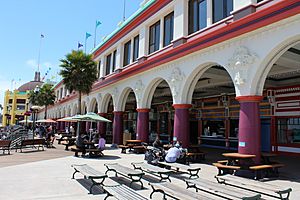
The main industries in Santa Cruz are farming, tourism, education, and technology. Santa Cruz is a leader in organic agriculture. Many special organic products come from here. The headquarters of California Certified Organic Farmers is also located in Santa Cruz.
Popular tourist spots include the Santa Cruz Beach Boardwalk, the redwood forests in the Santa Cruz Mountains, and Monterey Bay. Monterey Bay is a protected marine sanctuary.
Since the 1980s, many technology companies have chosen Santa Cruz as their home. These include companies like Plantronics.
Downtown Santa Cruz has many shops and businesses. You can often see street performers, musicians, and artists there. This adds to the unique and artistic feel of the city.
Major Employers in Santa Cruz
As of 2023, the biggest employers in Santa Cruz were:
- University of California, Santa Cruz (9,105 employees)
- County of Santa Cruz (2,804 employees)
- City of Santa Cruz (914 employees)
- Costco Wholesale Corp (314 employees)
- Safeway Inc. (224 employees)
- New Leaf Community Market (202 employees)
- DBA Santa Cruz Nutritionals (200 employees)
- Crow's Nest (194 employees)
- Santa Cruz Beach Boardwalk (186 employees)
- NHS, Inc. (148 employees)
Arts and Culture

Santa Cruz has many cultural places and attractions. These include:
- The University of California, Santa Cruz, Arboretum (a garden for trees and plants)
- Mission Santa Cruz
- The Santa Cruz Museum of Natural History
- The Santa Cruz Museum of Art and History
- The Santa Cruz Art League (with a gallery, theater, and classrooms)
- The Santa Cruz Surfing Museum (inside a lighthouse near Steamer Lane)
- The Tannery Arts Center
Santa Cruz also hosts many cultural events and festivals each year. The Cabrillo Festival of Contemporary Music is a yearly festival for orchestra music. It is known as a "new music mecca." Santa Cruz Shakespeare is a summer festival that performs plays by William Shakespeare.
Other popular events include the Santa Cruz Film Festival and the Santa Cruz Blues Festival. The O'Neill Cold Water Classic is a yearly surfing event at Steamer Lane.
The Open Studios Art Tour is an art fair that has been running for over 30 years. First Friday Santa Cruz is a monthly event where many art shows open.
The Santa Cruz County Symphony started in 1958. It is a professional orchestra with 65 members. They perform concerts every year.
Historic Places to See
By the 1860s, Pacific Avenue became the main street of downtown Santa Cruz. It still is today. The 1989 Loma Prieta earthquake destroyed almost all the old buildings from the 1800s in the downtown area.
After the earthquake, the downtown area was rebuilt with a new design. Today, only one empty lot remains from the earthquake's destruction.
Many landmarks in Santa Cruz are listed on the National Register of Historic Places. These include:
- The Branciforte Adobe
- The Cowell Lime Works Historic District
- The Golden Gate Villa
- The Hinds House
- Mission Santa Cruz
- The Neary-Rodriguez Adobe
- The Octagon Building
- The Santa Cruz Looff Carousel and Roller Coaster
Other important landmarks include Villa de Branciforte and the Santa Cruz Beach Boardwalk.
Sports and Fun Activities
The Santa Cruz Warriors are a basketball team in the NBA G League. The Santa Cruz Derby Girls are an amateur roller derby team. Both play at the Kaiser Permanente Arena.
Parks and Outdoor Activities
Santa Cruz has several state parks and beaches. These include:
- Lighthouse Field State Beach
- Natural Bridges State Beach
- Santa Cruz Mission State Historic Park
- Twin Lakes State Beach
- Seabright State Beach
The city also has three large open spaces: Arana Gulch, Moore Creek, and Pogonip. There are also many community and neighborhood parks.
Pogonip Open Space is next to the University of California, Santa Cruz. It has redwood forests, meadows, and streams. There are many hiking trails there.
Natural Bridges State Marine Reserve is a protected ocean area off the coast. Like underwater parks, these areas help protect ocean animals and their homes. Most of the Santa Cruz coastline is next to the Monterey Bay National Marine Sanctuary.
The Santa Cruz Wharf is a great place for fishing, seeing marine animals, and other fun activities. Local parks offer chances for birding and butterfly watching. You can also enjoy outdoor sports like skateboarding, cycling, camping, hiking, and rock climbing. The Santa Cruz Skatepark is free and open to everyone.
Santa Cruz is famous for surfing and skateboarding. It is also known for other sports like disc ultimate and disc golf. The DeLaveaga Disc Golf Course hosts tournaments.
Surfing in Santa Cruz
Santa Cruz is famous for water sports like sailing, diving, and swimming. It is known as one of the best places in the world for surfing. It is home to O'Neill Wetsuits and Santa Cruz Surfboards.
The Santa Cruz Beach Boardwalk is California's oldest amusement park. It is a State Historic Landmark and celebrated its 100th birthday in 2007. It has the famous Giant Dipper roller coaster, which is one of the oldest in the United States. It also has a 1911 Charles I. D. Looff Carousel.
In 1885, three Hawaiian princes were among the first to surf in California. They surfed on redwood boards at the mouth of the San Lorenzo River. Santa Cruz has 11 world-class surf spots. These include Steamer Lane and Pleasure Point, which have some of the best surfing waves anywhere.
The Santa Cruz Surfing Museum at Steamer Lane has people who have surfed Santa Cruz waves since the 1930s. Santa Cruz hosts several surf contests each year, bringing surfers from all over the world.
Education in Santa Cruz
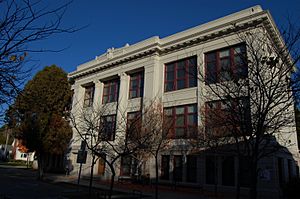
Santa Cruz has many schools and colleges. The city is served by the Santa Cruz City School District. Important public high schools include Santa Cruz High School and Harbor High School.
Private and charter schools include Georgiana Bruce Kirby Preparatory School (grades 6–12) and Pacific Collegiate School (grades 7–12).
Santa Cruz is also home to the University of California, Santa Cruz. There is also a campus of Cabrillo College in the city.
UC Santa Cruz has the Long Marine Laboratory. This is a marine research center on the western edge of the city.
Media and News
The Santa Cruz Sentinel is the only daily newspaper in Santa Cruz. The weekly newspaper Good Times also serves the area. The University of California, Santa Cruz has its own newspaper, City on a Hill Press. There is also an online newspaper called Lookout Santa Cruz.
Radio stations that broadcast from Santa Cruz include KSCO, KOMY, KZSC, KLVM, KSQL, KSQD, and KPIG-FM.
Getting Around Santa Cruz
Transportation in Santa Cruz
State Routes 1 and 17 are the main roads into and out of Santa Cruz. Route 17 is the main way to get to San Jose and the rest of the San Francisco Bay Area.
The closest airports with major airlines are San Jose International Airport, Monterey Regional Airport, San Francisco International Airport, and Oakland International Airport. The closest public airport for smaller planes is Watsonville Municipal Airport.
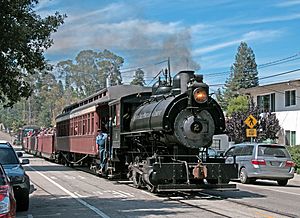
Horse-drawn trams started in 1876. Electric tram service began in 1881. These tram services ended in 1926 because of cars. Now, the Santa Cruz Metropolitan Transit District provides bus service throughout Santa Cruz County.
You can also get to Santa Cruz by Amtrak Thruway bus service. These buses connect to Amtrak trains at the San Jose Diridon Train Station.
Santa Cruz has many bike lanes and paths. Most major roads have bike lanes. There are also bike paths along the San Lorenzo River. A new bike and walking path along the coast, called the Rail Trail, is being planned.
The Santa Cruz, Big Trees and Pacific Railway runs tourist trains. These trains go between the Santa Cruz Beach Boardwalk and Roaring Camp in Felton. They pass through Henry Cowell Redwoods State Park and its famous Redwood Grove walking trail.
Water Supply
The main source of water for Santa Cruz is Loch Lomond Reservoir.
Sister Cities
Santa Cruz has several sister cities around the world:
 Alushta, Crimea, Ukraine (since 1984)
Alushta, Crimea, Ukraine (since 1984) Biarritz, France (since 2022)
Biarritz, France (since 2022) Jinotepe, Nicaragua (since 1990)
Jinotepe, Nicaragua (since 1990) Sestri Levante, Italy (since 1980)
Sestri Levante, Italy (since 1980) Shingū, Japan (since 1974)
Shingū, Japan (since 1974)
An inactive sister city relationship is:
 Puerto la Cruz, Venezuela (1966)
Puerto la Cruz, Venezuela (1966)
Images for kids
-
Mission Santa Cruz is a Catholic chapel.
-
Damage downtown caused by the 1989 Loma Prieta earthquake.
-
The Plunge Natatorium at the Santa Cruz Beach Boardwalk in 1910.
See also
 In Spanish: Santa Cruz (California) para niños
In Spanish: Santa Cruz (California) para niños








